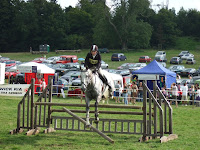 Some twelve months ago, plans were initiated for a family reunion: the date agreed finally rolled round as the family flew in from NZ and the US. The Kiwis - Alan, Sarah, Janine & Dave arrived late Thursday night (30th) and Bradley & Susan arrived before mid-day on Friday. Although the schedule for the day was
Some twelve months ago, plans were initiated for a family reunion: the date agreed finally rolled round as the family flew in from NZ and the US. The Kiwis - Alan, Sarah, Janine & Dave arrived late Thursday night (30th) and Bradley & Susan arrived before mid-day on Friday. Although the schedule for the day was  planned in great detail to ensure the overseas arrivals all made it to the destination at the right time, the logistics seemed to change by the minute through the day: we had planned to take 5 people by car and 3 by train, but after considering the amount of luggage piling up, all 6 young folk took the train.
planned in great detail to ensure the overseas arrivals all made it to the destination at the right time, the logistics seemed to change by the minute through the day: we had planned to take 5 people by car and 3 by train, but after considering the amount of luggage piling up, all 6 young folk took the train. When we first arrived at the boat-yard it was buzzing with people loading boats, having their lessons and setting off. We unloaded the car and set off for the supermarket and station for the first train arrivals; back to the boat to unload the provisions, then back to the station for the last of the train arrivals; then back to the boat for the final time and our introduction to narrow boating: by this time the boat-yard was deserted, just one last lonely craft waiting for its crew.
When we first arrived at the boat-yard it was buzzing with people loading boats, having their lessons and setting off. We unloaded the car and set off for the supermarket and station for the first train arrivals; back to the boat to unload the provisions, then back to the station for the last of the train arrivals; then back to the boat for the final time and our introduction to narrow boating: by this time the boat-yard was deserted, just one last lonely craft waiting for its crew.



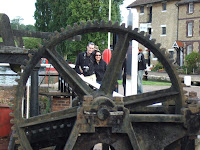
The instructor took us through the boat telling us all we needed to know; then up through the first lock before leaving us to set off on our holiday. At last, the fine vessel Splendid was all ours. A mile or so along the canal was The Globe and it was time to moor and eat.
 Although we had spent most of the day getting ourselves to the boat and only achieved an hour on the water, we rewarded for our efforts by a great meal at The Globe
Although we had spent most of the day getting ourselves to the boat and only achieved an hour on the water, we rewarded for our efforts by a great meal at The GlobeNot far along the canal from The Globe we arrived at the Soulbury Three Locks which, if you have no contra-flow traffic, as we did early Saturday morning, you can set up so that the next lock is ready and
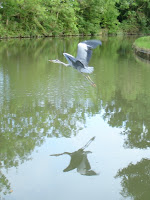 open as you exit the one above. After flooding the first lock, a boat moored nearby indicated they wanted to share the lock with us so we waited for them to cast off and join us. This meant that they were our companions through the Three Locks and the next lock as well, Stoke Hammond. The next lock, Fenny Stratford near Bletchley, is the shallowest lock on the Grand Union Canal and it dropped us just 33cm to the lowest point on our trip. From here there is 11 miles of cruising without a lock.
open as you exit the one above. After flooding the first lock, a boat moored nearby indicated they wanted to share the lock with us so we waited for them to cast off and join us. This meant that they were our companions through the Three Locks and the next lock as well, Stoke Hammond. The next lock, Fenny Stratford near Bletchley, is the shallowest lock on the Grand Union Canal and it dropped us just 33cm to the lowest point on our trip. From here there is 11 miles of cruising without a lock.

Our intention was to visit Milton Keynes centre on the way past but found, when we stopped to reconnoitre, that we were making such good progress that we had gone well past and were at Great Linford. After stopping for lunch we had a walk around the village and set off again for a short distance before stopping to look at the Bradwell Windmill and the aqueduct over a road.
 Not much further along was the second aqueduct, this time over the River Great Ouse.
Not much further along was the second aqueduct, this time over the River Great Ouse.  This is the second aqueduct to be constructed at this spot, the first collapsing in 1808, just three years after completion. The current aqueduct has provided much better value for money as it was completed in 1811 and is still going strong.
This is the second aqueduct to be constructed at this spot, the first collapsing in 1808, just three years after completion. The current aqueduct has provided much better value for money as it was completed in 1811 and is still going strong.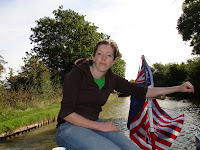



Shortly after the aqueduct is the Cosgrove Lock and then another 6 miles of canal to the foot of the Stoke Bruene flight. We figured that we could make it there before dinner but did not have time to traverse the flight in the available daylight. Mooring at the bottom gave us a 20-minute walk to The Navigation where we enjoyed another great meal.

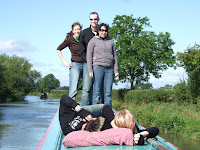
Another early morning start meant we had the locks to ourselves and could set them up in advance to facilitate a quick traverse. Once at the top
 we moored to enable us to look around Stoke Bruene's very attractive wharf area. It was too early for the Museum to be open so we decide to press on to the next challenge, the Blisworth Tunnel. At 2795m, this is the longest navigable tunnel in Britain and it is quite unsettling to pilot a boat through the darkness. Even though you may be quite adept at keeping a 62ft craft in a straight line in daylight, it takes some time to recalibrate the brain and achieve the same result in a tunnel. When passing an on-coming narrow boat, judging the distance (as it approaches) and width (as it passes) really tests the pilot.
we moored to enable us to look around Stoke Bruene's very attractive wharf area. It was too early for the Museum to be open so we decide to press on to the next challenge, the Blisworth Tunnel. At 2795m, this is the longest navigable tunnel in Britain and it is quite unsettling to pilot a boat through the darkness. Even though you may be quite adept at keeping a 62ft craft in a straight line in daylight, it takes some time to recalibrate the brain and achieve the same result in a tunnel. When passing an on-coming narrow boat, judging the distance (as it approaches) and width (as it passes) really tests the pilot. 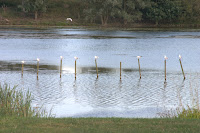 Two narrow boats at 7ft each passing in a 16ft tunnel leaves 8 inches each for the gaps between the walls and the boats and the between the boats: all very tricky when the lighting is a spotlight on the front of your boat (50ft away) and a spotlight on the on-coming boat (shining in your eyes.)
Two narrow boats at 7ft each passing in a 16ft tunnel leaves 8 inches each for the gaps between the walls and the boats and the between the boats: all very tricky when the lighting is a spotlight on the front of your boat (50ft away) and a spotlight on the on-coming boat (shining in your eyes.) Twenty-seven minutes later we emerged in to a tranquil wooded cutting and then passed our first junction, the canal up to Northampton. Eight miles further on we moored at Weedon Bec, which markets itself as "the heart of England", being the geographical centre of the country. Pressing on, we climbed another 7 locks and passed another junction, this time heading for Leicester, before entering
Twenty-seven minutes later we emerged in to a tranquil wooded cutting and then passed our first junction, the canal up to Northampton. Eight miles further on we moored at Weedon Bec, which markets itself as "the heart of England", being the geographical centre of the country. Pressing on, we climbed another 7 locks and passed another junction, this time heading for Leicester, before entering  the Braunston Tunnel. Adding to the difficulties of tunnel navigation, this one has a kink at one end and walls that meander in and out creating pinch-points where passing would appear to be impossible. Now at the highest point on our trip, the next 7 locks took us down to Braunston where we moored for the night and enjoyed another memorable meal at The Mill House.
the Braunston Tunnel. Adding to the difficulties of tunnel navigation, this one has a kink at one end and walls that meander in and out creating pinch-points where passing would appear to be impossible. Now at the highest point on our trip, the next 7 locks took us down to Braunston where we moored for the night and enjoyed another memorable meal at The Mill House.
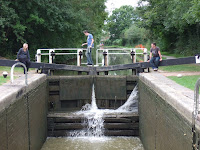


As we left the boat-yard so late on Friday, our instructor opined that we might not make it to Braunston; but we did, in two unhurried 10-hour days. However, it was now time to attempt a new manoeuvre,
 turning a 62ft boat around in a confined space. There are winding holes (pronounced win-ding, not wine-ding) at irregular locations along the canal and since Braunston is a canal junction, with the Oxford Canal joining, I naively assumed it would be an easy place to do a "three-point-turn". Unfortunately, unlike the previous two junctions
turning a 62ft boat around in a confined space. There are winding holes (pronounced win-ding, not wine-ding) at irregular locations along the canal and since Braunston is a canal junction, with the Oxford Canal joining, I naively assumed it would be an easy place to do a "three-point-turn". Unfortunately, unlike the previous two junctions  we had passed, at this junction there is a triangular "traffic island" in the location where I supposed I could make the manoeuvre easily. Immediately before the junction is a winding hole but there were boats moored along one side, significantly reducing the turning space. With the stern jammed hard against one bank and the bow touching the other, there was not a lot one could do. Fortunately Alan had stayed on board while the others explored Braunston marina and he was able to pull the bow around far enough for the stern to come away and allow manoeuvring to continue.
we had passed, at this junction there is a triangular "traffic island" in the location where I supposed I could make the manoeuvre easily. Immediately before the junction is a winding hole but there were boats moored along one side, significantly reducing the turning space. With the stern jammed hard against one bank and the bow touching the other, there was not a lot one could do. Fortunately Alan had stayed on board while the others explored Braunston marina and he was able to pull the bow around far enough for the stern to come away and allow manoeuvring to continue. The return trip was much the same as on the way there except that we arranged our arrival at Stoke Bruene to be during opening hours for the National Canal Museum and we all enjoyed perusing the displays. It was a very leisurely day as our intended destination was the Barley Mow pub at Cosgrove.
The return trip was much the same as on the way there except that we arranged our arrival at Stoke Bruene to be during opening hours for the National Canal Museum and we all enjoyed perusing the displays. It was a very leisurely day as our intended destination was the Barley Mow pub at Cosgrove.  The pub is accessed by a tunnel under the canal that was originally built as a means of getting the barge-towing horses from the tow-path to the stables at the pub. I have no idea why a tunnel was built when there is a perfectly serviceable bridge a few metres away.
The pub is accessed by a tunnel under the canal that was originally built as a means of getting the barge-towing horses from the tow-path to the stables at the pub. I have no idea why a tunnel was built when there is a perfectly serviceable bridge a few metres away.The aim of the day's cruising was to put us within easy cruising distance of Milton Keynes so that we could have time to explore on the following day. While the family was thinking about dragging themselves out of their berths Mum and Dad were off at Tesco in Wolverton, replenishing the supplies.
 At Milton Keynes we set off for AirKix to try some indoor flying. Unfortunately they were fully booked for the day and the earliest available time slot was 1 p.m. the next day. This threw our plans out of kilter as we had intended to be down at Bletchley Park the next morning.
At Milton Keynes we set off for AirKix to try some indoor flying. Unfortunately they were fully booked for the day and the earliest available time slot was 1 p.m. the next day. This threw our plans out of kilter as we had intended to be down at Bletchley Park the next morning. After much research into bus and train timetables and much discussion we thought we had a workable plan and cruised on down to Woughton on the Green where we enjoyed another memorable meal at Ye Olde Swan. Having moved on down the canal, the plans also moved and Bletchley was canned in favour of the Aerial Extreme adventure ropes course, back at our last mooring location. This presented another logistical problem but fortunately, there were winding holes in convenient locations, a few metres ahead of us and a few metres away from our last mooring location in Milton Keynes.
After much research into bus and train timetables and much discussion we thought we had a workable plan and cruised on down to Woughton on the Green where we enjoyed another memorable meal at Ye Olde Swan. Having moved on down the canal, the plans also moved and Bletchley was canned in favour of the Aerial Extreme adventure ropes course, back at our last mooring location. This presented another logistical problem but fortunately, there were winding holes in convenient locations, a few metres ahead of us and a few metres away from our last mooring location in Milton Keynes.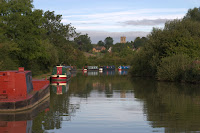



So, it was time to try the "three-point-turn" again, only it was more like a 7-point-turn. One really gets an appreciation of how long a 62ft narrow boat is when it is at right angles to the canal.

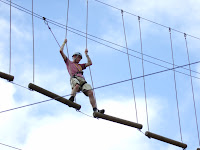
Bradley and Susan went off to sign themselves up for the rope course and the rest of us wandered along later to watch. After lunch, the intrepid flyers left early for their induction and the rest followed on later. Bradley, Susan, Alan, Sarah and Murray all flew with varying degrees of success and finesse. The overall conclusion was that women were better than men!


 Back on the boat it was 'full steam ahead' to make our final overnight destination, back at The Globe. We arrived just in time for our booking and were not disappointed on our return visit, as the meals were, once again, excellent.
Back on the boat it was 'full steam ahead' to make our final overnight destination, back at The Globe. We arrived just in time for our booking and were not disappointed on our return visit, as the meals were, once again, excellent.Along with the other 11 Wyvern boats that were moored near The Globe we set off in the morning to return 'Splendid' to the boatyard by 9 a.m.













